
Cunard Line is a British shipping and cruise line based at Carnival House at Southampton, England, operated by Carnival UK and owned by Carnival Corporation & plc. Since 2011, Cunard and its three ships have been registered in Hamilton, Bermuda.

RMS Aquitania was an ocean liner of the Cunard Line in service from 1914 to 1950. She was designed by Leonard Peskett and built by John Brown & Company in Clydebank, Scotland. She was launched on 21 April 1913 and sailed on her maiden voyage from Liverpool to New York on 30 May 1914. She was given the title of Royal Mail Ship (RMS) like many other Cunard ocean liners since she carried the royal mail on many of her voyages. Aquitania was the third in Cunard Line's grand trio of express liners, preceded by RMS Mauretania and RMS Lusitania, and was the last surviving four-funnelled ocean liner. Shortly after Aquitania entered service, the First World War broke out, during which she was first converted into an auxiliary cruiser before being used as a troop transport and a hospital ship, notably as part of the Dardanelles Campaign.
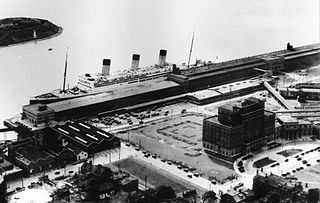
Pier 21 is a former ocean liner terminal and immigration shed from 1928 to 1971 in Halifax, Nova Scotia, Canada. Nearly one million immigrants came to Canada through Pier 21, and it is the last surviving seaport immigration facility in Canada. The facility is often compared to the landmark American immigration gateway Ellis Island. The former immigration facility is now occupied by the Canadian Museum of Immigration, the Nova Scotia College of Art and Design as well as various retail and studio tenants.
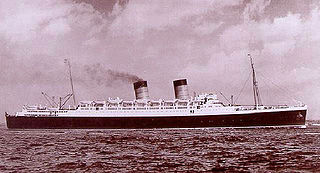
RMS Mauretania was an ocean liner that was launched on 28 July 1938 at the Cammell Laird yard in Birkenhead, England, and was completed in May 1939. She was one of the first ships built for the newly formed Cunard-White Star company following the merger in April 1934 of the Cunard and White Star Line. On the withdrawal of the first Mauretania in 1935, to prevent a rival company using the name and to keep it available for the new liner, arrangements were made for the Red Funnel paddle steamer Queen to be renamed Mauretania in the interim.

RMS Caronia was a Cunard Line transatlantic steam ocean liner. She was launched in 1904 and scrapped in 1932. In World War I she was first an armed merchant cruiser (AMC) and then a troop ship.

SS Manhattan was a 24,189 GRT luxury ocean liner built for the United States Lines, named after the Manhattan borough of New York City. On 15 June 1941 she was commissioned as USS Wakefield (AP-21) and became the largest ship ever operated by the US Coast Guard. In 1942 she caught fire and was rebuilt as a troop ship. Post-war, she was moored in New York in May, before decommissioning in June 1946. She was laid up in reserve at Jones Point, New York. She never saw commercial service again, and was sold for scrap in 1965.
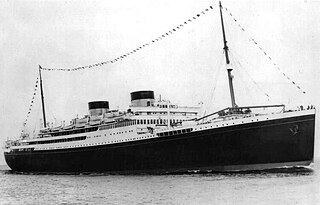
MV Britannic was a British transatlantic ocean liner that was launched in 1929 and scrapped in 1961. She was the penultimate ship built for White Star Line before its 1934 merger with Cunard Line. When built, Britannic was the largest motor ship in the UK Merchant Navy. Her running mate ship was the MV Georgic.

SS Orduña or Orduna was an ocean liner built in 1913–14 by Harland and Wolff in Belfast for the Pacific Steam Navigation Company. After two voyages she was chartered to Cunard Line. In 1921 she went to the Royal Mail Steam Packet Company, then being resold to the PSNCo in 1926. Her sister ships were Orbita and Orca.

MV Georgic was the last ship built for the White Star Line before its merger with the Cunard Line. Built at Harland and Wolff shipyard in Belfast, she was the running mate of MV Britannic. Like Britannic, Georgic was a motorship, and not a steamer, fitted with a diesel powerplant. At the time of her launch in 1931, she was the largest British motorship.
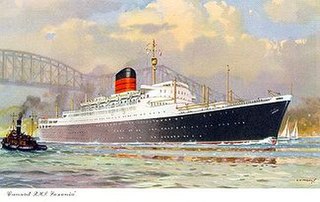
RMS Saxonia was a British passenger liner built by John Brown & Company at Clydebank, Scotland for the Cunard Steamship Company for their Liverpool-Montreal service. She was the first of four almost identical sister ships built by Browns between 1954 and 1957 for UK-Montreal service. The first two of these ships, Saxonia and Ivernia were extensively rebuilt in 1962/3 as dual purpose liner/cruise ships. They were renamed Carmania and Franconia respectively and painted in the same green cruising livery as the Caronia. Carmania continued transatlantic crossings and cruises until September 1967 when she closed out Cunard's Montreal service. She and her sister had been painted white at the end of 1966 and from 1968 Carmania sailed as a full time cruise ship until withdrawal after arriving at Southampton on 31 October 1971. In August 1973 she was bought by the Soviet Union-based Black Sea Shipping Company and renamed SS Leonid Sobinov. The ship was scrapped in 1999.

SS Zeeland was a British and Belgian ocean liner of the International Mercantile Marine Co. (IMM). She was a sister ship to Vaderland and a near sister ship to Kroonland and Finland of the same company. Although her name was Dutch, it was changed during World War I to the less German-sounding SS Northland. She served for a time as a British troop ship under the name HMT Northland. Reverting to Zeeland after the war, the ship was renamed SS Minnesota late in her career. Zeeland sailed primarily for IMM's Red Star Line for most of her early career, but also sailed under charter for the White Star Line, the International Navigation Company, the American Line, and the Atlantic Transport Line, all IMM subsidiary lines. The pursers safe survived the scrapyard at Inverkeithing and after residing in a wardrobe for 80 years is currently on display in a local private home.

SS Letitia was an ocean liner built in Scotland for service with the Anchor-Donaldson Line. She continued to serve with its successor company Donaldson Atlantic Line. At the start of the Second World War in September 1939, the British Admiralty requisitioned the ship for service and had it converted to serve as an armed merchant cruiser. She was withdrawn from this service in 1941 to become a troop ship.

SS Lapland was a steam ocean liner built in Ireland for the Belgian Red Star Line, as Red Star's flagship, similar in appearance to the fellow liners SS Samland, SS Gothland and SS Poland, but far larger. She was a half sister to White Star Line's "Big Four." They were similar in many ways, such as the island bridge, 4 masts, 2 funnels. But Lapland had a less luxurious interior.

The Britannia class was the Cunard Line's initial fleet of wooden paddlers that established the first year round scheduled Atlantic steamship service in 1840. By 1845, steamships carried half of the transatlantic saloon passengers and Cunard dominated this trade. While the units of the Britannia class were solid performers, they were not superior to many of the other steamers being placed on the Atlantic at that time. What made the Britannia class successful is that it was the first homogeneous class of transatlantic steamships to provide a frequent and uniform service. Britannia, Acadia and Caledonia entered service in 1840 and Columbia in 1841 enabling Cunard to provide the dependable schedule of sailings required under his mail contracts with the Admiralty. It was these mail contracts that enabled Cunard to survive when all of his early competitors failed.

The America class was the replacement for the Britannia class, the Cunard Line's initial fleet of wooden paddle steamers. Entering service starting in 1848, these six vessels permitted Cunard to double its schedule to weekly departures from Liverpool, with alternating sailings to New York. The new ships were also designed to meet new competition from the United States.

RMS Franconia was an ocean liner operated by the Cunard Line from 1922 to 1956. The liner was second of three liners named Franconia which served the Cunard Line, the others being RMS Franconia built in 1910 and the third Franconia in 1963.
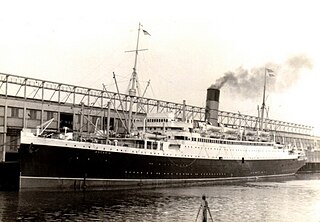
The RMS Ascania was an ocean liner operated by the Cunard Line. She was launched on 20 December 1923 at the Armstrong Whitworth Shipbuilders Ltd yard in Newcastle-upon-Tyne; the fifth of Cunard's six "A" class liners. Due to unforeseen cost overruns, the vessel was not completed until May 1925. Following service in a number of military roles during the Second World War, she was refitted and returned to civilian use in 1950, finally retiring in 1956.

RMS Samaria was a transatlantic ocean liner built for Cunard Line. She was completed in 1922 and served until 1955. In the Second World War she was a troopship in the Royal Navy. Samaria was scrapped in 1956. Samaria was a sister ship of RMS Scythia and half-sister of RMS Franconia.
RMS Andes was a 26,689 GRT steam turbine Royal Mail Ship, ocean liner, cruise ship, and the flagship of the Royal Mail Lines fleet. She was the second Royal Mail ship to be named after the South American Andes mountain range. The first RMS Andes was an A-class liner launched in 1913. In 1929 that RMS Andes was converted into a cruise ship and renamed Atlantis.

SS Stratheden was a UK-built steam turbine ocean liner. She spent most of her career with the Peninsular and Oriental Steam Navigation Company, including the Second World War when she served for six years as a troop ship.



















